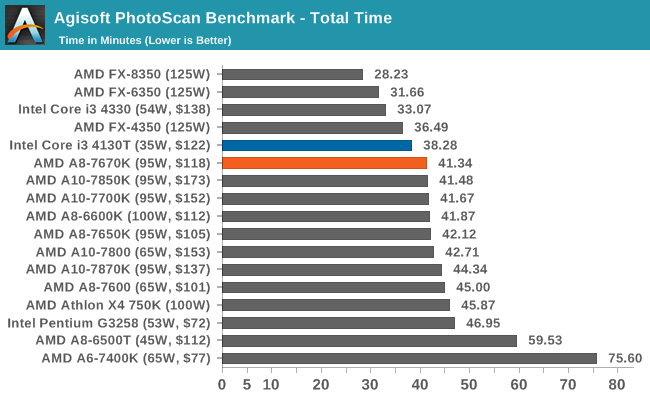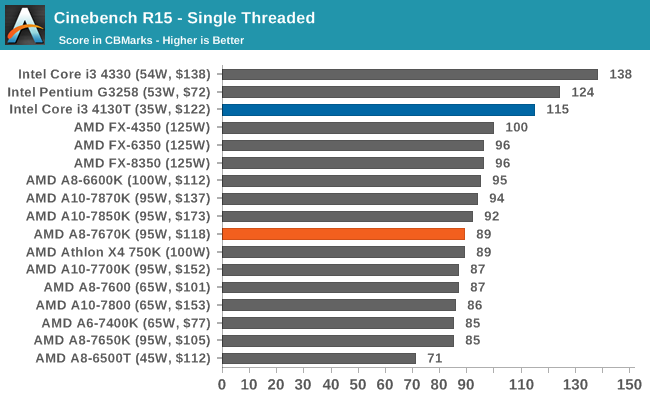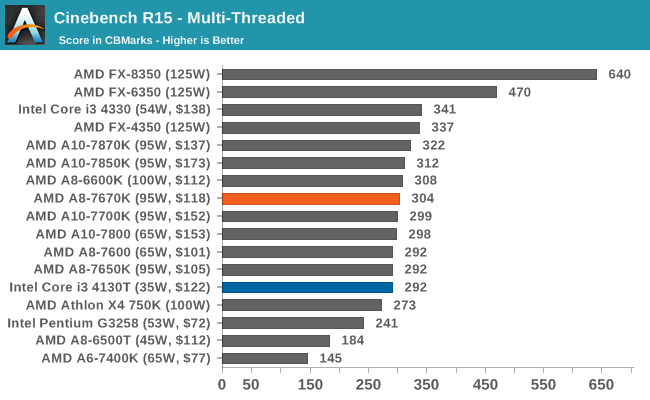The AMD A8-7670K APU Review: Aiming for Rocket League
by Ian Cutress on November 18, 2015 8:00 AM ESTProfessional Performance: Windows
Agisoft PhotoScan – 2D to 3D Image Manipulation: link
Agisoft PhotoScan creates 3D models from 2D images — a process that is very computationally expensive. The algorithm is split into four distinct phases, and different phases of the model reconstruction require either fast memory, fast IPC, more cores, or even OpenCL compute devices to achieve the best performance. Agisoft supplied us with a special version of the software to script the process, where we take 50 images of a stately home and convert it into a medium-quality model. This benchmark typically takes around 15 to 20 minutes on a high-end PC on the CPU alone, with GPUs reducing the time.

PhotoScan shows most APUs performing around 41 to 42 minutes, which suggests that there is a bottleneck in the core design.
Cinebench R15
Cinebench is a benchmark based around Cinema 4D, and is fairly well known among enthusiasts for stressing the CPU for a provided workload. Results are given as a score, where higher is better.


HandBrake v0.9.9: link
For HandBrake, we take a video (a 2h20 640x266 DVD rip) and convert it to x264 format in an MP4 container. Results are given in terms of the frames per second processed, and HandBrake uses as many threads as possible.











154 Comments
View All Comments
BurntMyBacon - Thursday, November 19, 2015 - link
@Ian Cutress: "It's never an issue of lack of interest or subversion, just procurement (and ensuring we can communicate with the manufacturer at the point of testing)."[sarcasm]I thought Intel and all other computer hardware manufacturers were required by LAW to send their products to Anandtech for prelaunch approval where Supreme Tech Justice Cutress and his colleagues pronounce life or death on potential products. ;' ) [/sarcasm]
Seriously though, I'd say you are doing fine despite the real world procurement and scheduling issues getting in the way.
flabber - Wednesday, November 18, 2015 - link
I can't agree any more with the point that power consumption is the least of my concerns. While there is a significant difference between a 250W TDP CPU and a 50W TDP CPU, where one would have to factor in the cost of cooling and a PSU, 100W is quite manageable. A 500W PSU is more that adequate for just about any current system. However, I am aware that decreased power consumption is an objective in all consumer products and will be seeing in upcoming computer components. (Ironically for mobile components, my 2009 Blackberry with a 1150mAh battery can still run for a couple days before I need charge it.)My rig is equipped with a A10-5800k (2012) and a year old R9-290X (2013). Everyday tasks, such as using a spreadsheet, word processor, citation management or occasional image editing, can't be improved in any noticeably way. With regard to gaming, I can't be bothered to upgrade the motherboard and CPU to a superior Intel alternative. A few more frames per second won't make a game with poor storyline any better, nor will an enjoyable game become any better.
Pissedoffyouth - Thursday, November 19, 2015 - link
If you have 5800 you should look at getting a kaveri for better performance and lower power consumptionGadgety - Thursday, November 19, 2015 - link
"AMD's first talking point is, of course, price. AMD considers their processors very price-competitive"No kidding, I got the A8-7600 for my kid and it's integrated graphics is comparable to the i7 Iris Pro, where the i7 is 5x more expensive. So for 20% of the price we get to enjoy graphics galore. Put it on Asrock's A88X M-ITX motherboard and it outputs 4K cinema. No graphics card means it's compact so we use a tiny chassis, perfect HTPC, and useable for the type of light gaming the kids do.
Gadgety - Thursday, November 19, 2015 - link
@Ian Cutress The performance parity, and sometimes superiority, of the A8-7670k compared to the A10-7850k, and also to the A10-7870k, I guess could be attributable to driver improvements. Did you use the same drivers, or updated versions? If it's improved drivers, this would likely also improve across the APU-range.Ian Cutress - Thursday, November 19, 2015 - link
Same drivers for each. I lock a set of drivers down every test-bed refresh, so in this case it would be 15.4 beta, which is getting a bit old now. Kaveri Refresh does have some minor internal improvements as well I imagine, internal bus frequencies perhaps. There's always a small amount of volatility in the benchmark, depending on what heat density or board issue you might have. Looking back, we haven't always used the same motherboard on the APUs just due to timing (but all A88X), and even though we do some overriding on power profiles it can be difficult to compensate for motherboard manufacturer non-user exposed firmware optimisations on the memory buses.Come the next year test-bed refresh (with DX12 relevant titles hopefully), I'll be going back and redoing them all. That should clear out the cobwebs on the latest drivers and updates, providing a new base.
milli - Thursday, November 19, 2015 - link
Ian Cutress, how is the review of your grandparents laptop coming along? :)I'm waiting for that Carrizo review.
zlandar - Thursday, November 19, 2015 - link
I don't see the point of being so cheap that you are unwilling to spend more for a superior i3-5 and discrete video card. Why would you chain yourself to a dead-end cpu/gpu integrated combo and motherboard that isn't very good to start with?Plenty of people have pointed out how well Intel's cpu have held up since Sandy Bridge. I'm still using a 2600k and have upgraded my video card 3 times. If you are on a tight gaming budget it makes alot more sense to buy 2nd-3rd tier last gen video cards coupled with a good cpu you don't need to upgrade.
BurntMyBacon - Thursday, November 19, 2015 - link
@zlandar "Why would you chain yourself to a dead-end cpu/gpu integrated combo and motherboard that isn't very good to start with?"Aren't just about all laptops deadend with respect to CPU/GPU? (Particularly in the Carrizo price range)
Ton's of laptops are sold without discrete GPUs and no option to upgrade. Why should this matter to a Carrizo review (clearly laptop in this request)?
Ian Cutress - Thursday, November 19, 2015 - link
Something special in the works. After SC15 finishes, I'll be digesting the mountain of data I have. :)